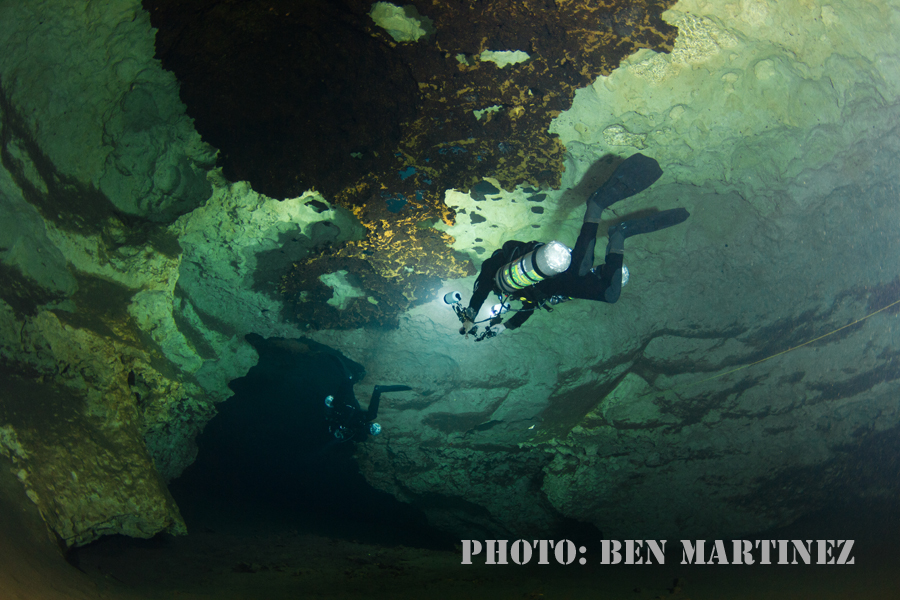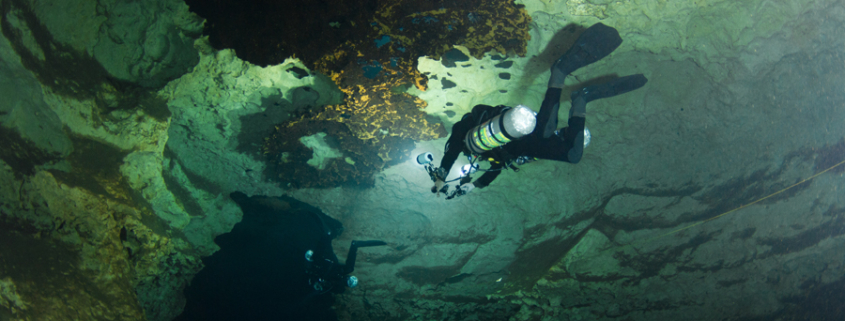Sidemount Diving: It’s Not Just for Caves
By Steve Lewis

Perhaps typical of divers who use and teach sidemount today is the phrase, “it’s not just for technical divers anymore!” And the truth is that sidemount is a truly versatile kit configuration that in the past few years has stormed into just about ALL areas of technical diving (even rebreather divers side-mount their bailout bottles!), as well as gaining favor with sport divers who have no intention of pushing ANY limits whatsoever. However, it’s worth remembering that for all the flexibility and adaptability that sidemount configuration offers to tech and sport divers, it started as some weirdness that only crazy cave divers got up to.
My personal introduction to “sidemount” was as a kid dry-caving in the UK. We were not divers, but we had access to small cylinders filled with air – probably three or four litre steel tanks about the size of the bottles you’d find on most rebreathers these days – and there were a couple of short sumps between us and the best parts of the caves we were playing around in. We strapped a tank to the side of a climbing harness, put the regulator in our mouths, and walked/crawled through the sump. And believe me, the reality was a lot less dramatic than the description. The sumps – a part of the cave completely underwater – were probably no longer than we could have covered holding our breath, and the cave we were exploring, at least the part we were exploring, was a very well-travelled passage. Nothing at all note-worthy.
The point being that if we’re looking for the spot to place a commemorative plaque celebrating the beginnings of sidemount “diving” in caves, we could easily argue for the Mendip Hills, in England’s West Country. In fact, that area has been – and remains – the focus for “real” cave diving and true exploration since the late 1930s.
But, if the birth of sidemount cave diving took place in England, the technique was raised to adulthood in the area of North Florida famous for its karst landscape, fresh-water springs, pioneering explorers, and organized clubs and associations promoting ecology, preservation, understanding, and formal dive training.
Within a generation, SM (sidemount) cave diving, as taught and promoted in Florida’s cave country, has evolved from a somewhat marginal extreme undertaken by a tiny percentage of trained cave divers, to a level where today, in some systems, close to 100 percent of the divers playing in the cave are configured in sidemount gear. In short, it has grown to the point where the question, “Who does that crazy stuff?” seems to have morphed into, “Who isn’t doing it?”
So, if we know who – everyone or close to everyone – let’s find out why and how.
Why use SM in a cave? Well, the traditional answer would be that a sidemount configuration allows a diver access to areas that would simply not be open to them if they carried tanks on their back.
Configured correctly, SM gear is extremely streamlined: that is, when hoses are optimal lengths, nothing is left hanging off the diver to simulate being a Christmas tree decoration, and primary bottles run along the diver’s lateral line without their noses pointing to the floor and their backsides in the air. The diver’s in-water top-to-bottom profile is much smaller than when wearing doubles, a single or a rebreather. It’s true that her side–to-side profile will be wider (incidentally giving a very comfortable lateral stability), but the way sidemounted tanks are attached to the diver’s harness allows them some latitude to move out of the way when side-to-side space gets restricted.
Indeed, a skill taught to SM students, during even a very basic orientation class and certainly in a SM cave diving program, is to unclip the rear snaps and swing one or both cylinders around so that while the tanks nose remains attached, the bottoms now face forward. This gives the diver a very long, narrow profile.
In short, for smaller, tighter spaces, sidemount rocks.
By the way, this last technique is NOT no-mount diving. No-mount is an extremely advanced technique used to explore very tight passages. The diver pushes a SINGLE, unattached cylinder ahead of them through small passages. Doing this offers access in very limited space, but is hugely risky for several reasons, not the least of which is that the diver has zero back-up gas and may have to exit without being able to turn around. For the record, John Chatterton famously used this technique to explore the U-Who wreck.
A lot of sidemount’s popularity is due to the wide-spread availability of purpose-bought SM harnesses. In sidemount’s adolescent years, sidemount cave divers used stab jackets (traditional sport BCDs) as the core of their SM kit. These were highly modified with bungee, bolt-snaps, sewn loops of webbing and added DRings to the point where when modifications were completed, the end-result was barely recognisable as a shop-bought piece of sport diving kit.
This DIY approach certainly seemed to restrict the growth and popularity of sidemount diving. A change came when mainstream equipment companies started to sell integrated wing and harness rigs custom-designed for sidemount cave diving. The leader on this score was Dive Rite, a cave-oriented manufacturer based in North Florida but with distribution world-wide. Currently, Dive Rite sells several models of SM harness each designed for a slightly different purpose and are probably the best-known and most popular SM brand. But they are no longer alone, and several other companies have one or two models on the market including Hollis, Oxychek and OMS.
This sudden explosion of available, well-built, purpose-designed harnesses – and the accessories such as CAM bands and various length LP and HP hoses that make rigging for SM much less of a DIY project than it was just a handful of years ago – has helped fuel the growth of SM cave diving. But there is certainly something else at play.
Lamar Hires, president of Dive Rite, describes it as a life-style choice. “Using SM to explore tight spaces is a mission-specific decision,” he says, “But a lot of divers are uncomfortable carrying a set of double cylinders, and for them, SM offers a lot less stress because cylinders can be carried to the water one at a time!”
And a straw-poll of a lot of SM cave divers turns up that the number one reason for being configured the way they are is convenience and comfort, rather than something “mission specific.”
The ‘HOW’ of SM cave diving is what’s taught in a TDI Sidemount Diver course. Most of the techniques and procedures are the same as a “regular” cave course with kit configuration being one major difference. Another is the slightly more complex system employed to manage gas volume. With two independent cylinders as opposed to two cylinders joined by an isolation manifold, the diver has to switch regulators during her dive to distribute gas consumption “evenly” between each tank.
In all TDI overhead programs, the Rule of Thirds and related modification of it are hammered into students’ minds with constant repetition. The simple mantra of “one-third in, one-third out, one-third (plus an additional reserve) for contingencies” holds true for SM cave diving, but there is a twist on account of the need to swap regs during the dive.
There are a couple of protocols that are taught but one that is popular goes like this:
Given that gas-matching and volume requirements are worked out and agreed with the rest of her team, the diver begins her dive breathing from Tank A. When she has consumed ONE SIXTH of her available volume, she switches regs and begins to breathe from Tank B. She continues to breathe it until she has consumed ONE THIRD of her available volume, at which point she switches regs once again. She is now back to breathing from Tank A. When she has consumed ONE SIXTH of its volume (which adds up to a total of ONE THIRD of the available volume in EACH cylinder), she signals turn the dive. But she keeps breathing from Tank A until she has used an additional SIXTH. At which point she switches regs for the last time. Let’s use some simple numbers to illustrate the point (and we’ve avoided using pressures or actual volumes to make this work for both imperial and SI unit users, and the asterisk indicates the tank being breathed from).
| START OF DIVE (* DENOTES ACTIVE TANK) | *TANK A = FULL; TANK B = FULL |
| FIRST REG SWITCH | TANK A = 5/6 FULL; *TANK B = FULL |
| SECOND REG SWITCH | *TANK A = 5/6 FULL; TANK B = 2/3 FULL |
| TURN DIVE | *TANK A = 2/3 FULL; TANK B = 2/3 FULL |
| THIRD AND FINAL REG SWITCH | TANK A = 3/6 FULL; *TANK B = 2/3 FULL |
| CONTINUE UNTIL EXIT… | TANK A = 3/6 FULL; * TANK B = AT LEAST 1/6 AT EXIT |
Using this technique, the difference between the two tank volumes during the critical phases of the dive are never more than one-sixth of the starting pressure. In the event of an OOA situation at the maximum penetration, the OOA diver can be given a cylinder containing 2/3 of the starting volume… enough to get them out if proper gas management rules are followed. As the exit progresses, the gas buffer, the contingency, gets wider and wider. Using this method, there are only three regulator switches. Most other options require more.
Obviously, there’s much more to be said about SM cave diving – that’s what a course is for – but we hope this has at least reminded you where the SM “craze” started: wet rocks and holes in the ground, like so many of the innovations in diving today!
Have fun, and dive safe.
Below are a few of the TDI sidemount/cave courses offered.
TDI Sidemount Diver >
TDI Cavern Diver >
TDI Intro to Cave Diver >
TDI Full Cave Diver >
Contact SDI TDI and ERDI
If you would like more information, please contact our World Headquarters or your Regional Office.
Tel: 888.778.9073 | 207.729.4201
Email: Worldhq@tdisdi.com
Facebook: www.facebook.com/TechnicalDivingInt


Leave a Reply
Want to join the discussion?Feel free to contribute!